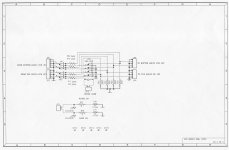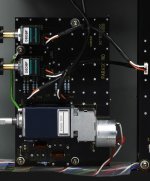Please bear with me, the schematics from the past show a 10K volume control pot. The situation without any more knowledge would be that to get pass through operation at 4V you turn the pot down to attenuate by the same amount as the fixed gain. At 20dB this would mean ~0.4V at the input with ~1K input resistance. I don't see this causing that much distortion simply due to the input capacitance modulation especially since Vgd is relatively high. The SK170/SJ74 pair has values for the capacitances on the data sheet and they obey the theoretical 1/3 power law, for this effect simulation will give reasonable results.
There is a divider pot (gain) in front of the volume pot.
Attachments
how does deciding resistance of the volume pot come into play?
for example my halo integrated has a 100k pot.
for example my halo integrated has a 100k pot.
1) JFETs have non-linear input capacitance. The higher the volume output impedance, the higher the distortion.
2) higher pot impedance reflects in higher noise. Just standard resistor noise, directly proportional to resistance.
2) higher pot impedance reflects in higher noise. Just standard resistor noise, directly proportional to resistance.
Not trying to wind Pavel up here but I see very few cases in domestic audio where the gain structure is optimal for this. Maybe will change over time?
This technical issue, ignoring the massive fru-fru parts of this site, is what baffles me the most among the digit-counters. If you are in control of the entire playback chain, why on earth wouldn't you optimize your gain structure *and* gain-early with essentially current gain power amplifiers. DAC + 36V process opamps = easy to get pretty high signals right at the front of the chain with low distortion.
Obviously plenty of people reject this idea for whatever reason, but the high sensitivity ppm-targeted amps are head scratchers.
Isn't higher voltage "small signal" amplification and low input impedances the way? I have a Doug Self preamp that uses 5k pots and he designed one that uses 1k.
<snip>
Furthermore if you apply 2V/4V of input voltage (fully modulated source) to a unity gain preamp at full volume what would you expect to measure as output voltage?
Nobody forced it's use like that and it isn't a "unity gain preamp at full volume" (quite frankly it is very different) and as said before again, if you want to examine the strengths and the weak spots it is sound to use such signals, but nobody should even pretend that it reflects the "normal" use of such a preamplifier at home.
@PMA,
As usually, you are rather political than strictly technical.
You're simply projecting.
Your game is not fair enough. There are many amplifiers that need more than 2V to get full power. One of them is Passlabs X600. 600W into 8ohms, gain 26dB. You need about 3.5V input to get rated power.
All fine, what about choosing another preamplifier if that's your need?
If you need less output voltage, maybe this preamplifier has something that you like........
Daniel: Except for the Pass F4 and a Musical fidelity amplifier I forget the name of very people have dared to go the unity gain power amp route. But like you I don't see a lot of justification for over 10dB gain in the power amp.
IIRC, Hawksford JAES article from the 80s was one of the first (if not the first) proposals of the low-gain power amplifier/high-gain preamplifier scheme.
You'll have to build your own Bill, DIY, did you see the link I posted earlier of Pavel's on Rod's site? I've been tempted.
I also converted the Maplin Hitachi mosfet amp to unity gain, that was fun
I also converted the Maplin Hitachi mosfet amp to unity gain, that was fun
Last edited:
1) JFETs have non-linear input capacitance. The higher the volume output impedance, the higher the distortion.
2) higher pot impedance reflects in higher noise. Just standard resistor noise, directly proportional to resistance.
Really? Now you are catching on, PMA. '-)
then why would one purposefully use a 100k pot?
A friend received a Currus Hermes MKI with RCA WBT 0102 Cu from a local dealer today, with a bail only for listening. I was very skeptical about the use of rare earth metals as conductors. But the sound of the audio system with these cables was really better. As if from above, the frequency range is extended by a couple of octaves. He is also very neutral and builds a convincing 3D scene. Since there is little price difference between MKI and MKII, he decided to try MKII as well.
Interconnects | arkana-research
https://www.salonav.com/wp-content/uploads/2017/12/Arkana_Research_01.jpg
Interconnects | arkana-research
https://www.salonav.com/wp-content/uploads/2017/12/Arkana_Research_01.jpg
Last edited:
They should have used a 50K pot, but they wanted you to more comfortably be able to connect your old tube FM tuner to the input. 10K doesn't cut it, too hard on the drive tube from the tube source.
Nobody forced it's use like that and it isn't a "unity gain preamp at full volume" (quite frankly it is very different) and as said before again, if you want to examine the strengths and the weak spots it is sound to use such signals, but nobody should even pretend that it reflects the "normal" use of such a preamplifier at home.
If you are happy with a preamp that clips your power amp at 11 hours volume pot position with a fully modulated signal good for you
You'll have to build your own Bill, DIY, did you see the link I posted earlier of Pavel's on Rod's site? I've been tempted.
It's in the long term evolution plan. I'm going to 8V balanced in the current refurb.
Main volume pot is 50K, not 10K.
OK, I've been looking at the 70's/80's schematic posted in the 2008 thread on the Chinese clones.
I personally find having two level controls in a signal chain asking for problems. Anyone here remember the first cable TV stereo was analog with a pilot tone like FM? I demonstrated to an installer how easy it was to adjust for a comfortable volume with different settings on the cable box's and TV's volume control so that the pilot fell below detection and the stereo turned off.
The installer left saying simply the TV was broken.
Last edited:
The frequency range extention by a couple of octaves would be a miraculous achievement.
Post deserves the Promotion Medal of the decade.

George
Post deserves the Promotion Medal of the decade.

George
Especially if your ears are a measuring device. This already definitely attracts a Nobel Prize.. 😉
Last edited:
Can't my volume pot is digital with about 50 turns.
Fine, but if you have too much gain in your power amp you have to chuck 4 bits away just to preserve your hearing/drivers/marriage. Some people angst over that 🙂
Not so. Everything digital works with full word length, including the DAC's. The volume control in the DAC produces better results in attenuation than truncating bits would. I tested.
- Home
- Member Areas
- The Lounge
- The Black Hole......

